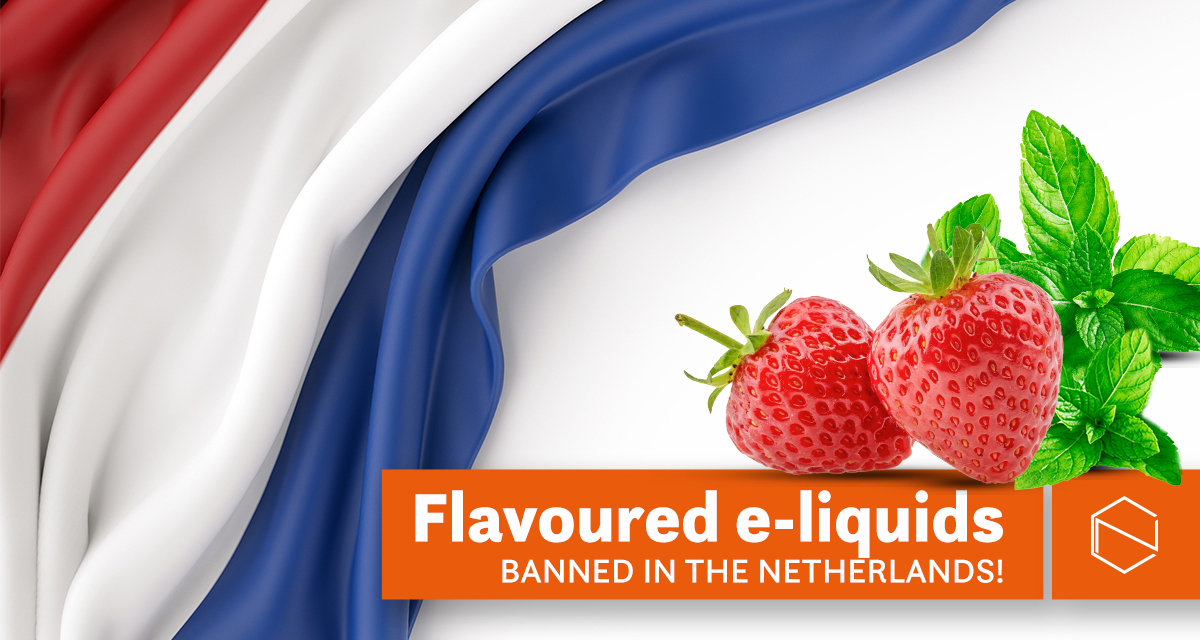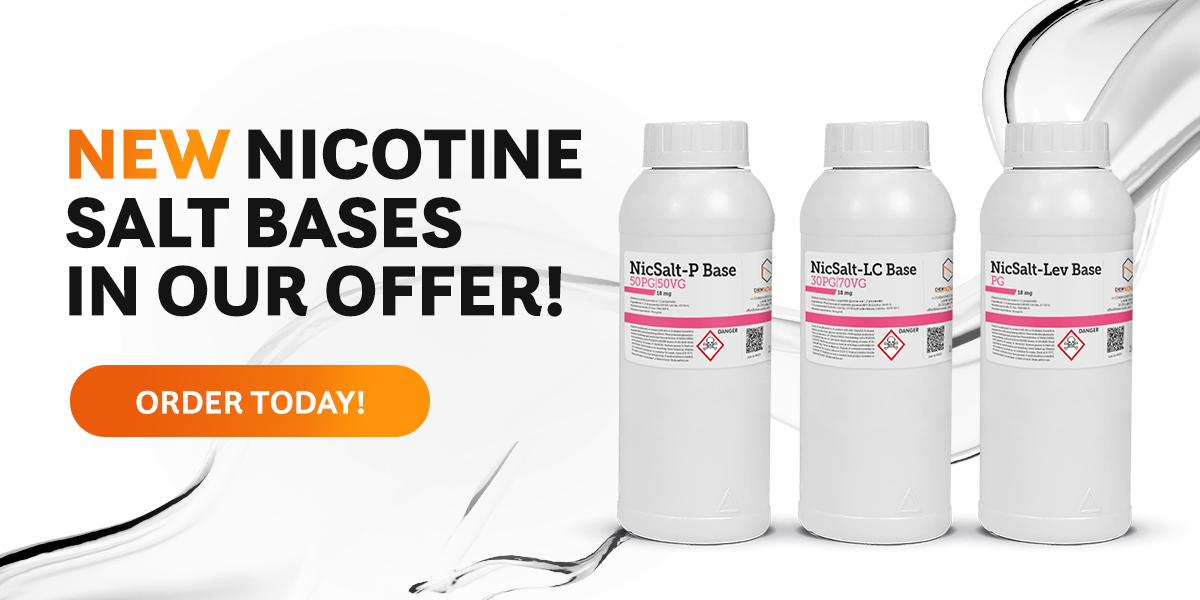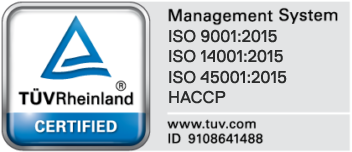
Netherlands Vape Ban has become a fact. In the last days of November 2022, the Dutch authorities published an amendment that clearly stated – flavored e-liquids would be banned in the Netherlands. Thus, it will become another country where such restrictions will come to life. But it is not the end. The Dutch Government aims to reduce the appeal of e-cigs and realize its goal of attaining a “smoke-free generation by 2040”. What’s the future of vaping in the Netherlands?
Check more:
- Vape & E-Liquid Regulations [Knowledge Base]
- Vaping Trends 2024: How Can They Help Grow Your Profitable Business?
- E-Liquid Regulations In The World
- E-Liquid Regulations Guide: Get Your Free E-Book!
- Industry Regulations: REACH And CLP
- What Is UFI Code And How Does It Apply To The E-Liquid Industry?
- Fees, Taxes And More: An Analysis Of Selected Regulations In Europe
Vaping in the Netherlands: since when are flavored vape juices banned in the Netherlands?
Up to that point, the e-liquid flavorings ban was a thing to expect, as back in 2020, the authorities announced they were planning to ban flavoured e-cigarettes and vapes. Since 28 November, the exact date is known. The ban came to life starting 1 October 2023.
We have been in the vape and e-liquid sector since 2013. Dozens of clients have trusted us and we have launched over 300 products and brands. Use our resources and experience and together we will earn your success – rapidly check our Knowledge Base.
Netherlands vape ban: more details
Flavour ban in the Netherlands: Only tobacco flavor e-liquids remain allowed
The main part of the new legislation is that starting on 1 October 2023, sales of flavored vape liquids and e-cigarettes with fruity, sweet, drink, mint, and more aromas will not be legal.
However, there will be an exception. Tobacco e-liquids will remain allowed if one condition is met. They can contain only 16 allowed substances:
- beta-Damascone
- (E)-beta-Damascone
- (Z)-beta-Damascone
- Damascenone
- (E)-beta-Damascenone
- Ketoisophorone
- 2-Hydroxy-3,5,5- trimethyl-2- cyclohexenone
- 3-Ethylpyridine
- 3-Acetylpyridine
- 2,6-Dimethoxyphenol
- 5-(Hydroxymethyl)- 2-furfural
- alpha-Angelica lactone
- Isovaleric acid
- (-)Caryophyllene oxide
- Ambroxide
- (3aR)-(+)-Sclareolide
As the NLTimes states: according to RIVM (National Institute for Public Health and the Environment) about a quarter of the current tobacco flavors can be made with that list of ingredients.
On the other hand, Emil ‘t Hart, from the trade association Esigbond, has a different opinion: “We were able to taste the first variants. That’s a very weak derivation of what should be a tobacco flavor“.
The Dutch government aims to reduce the appeal of e-cigarettes, especially among young people. “E-cigarettes contain vaping flavour to make the product more appealing. Dutch vapers particularly like sweet flavors and fruit flavors. Accordingly, the government has only allowed flavorings with a tobacco taste” – RIVM says.
Vapes in the Netherlands: Only tobacco-related words and images are allowed
The ban not only forbids flavours other than tobacco manufactured with the use of allowed substances but also applies to the packaging. These can not contain images related to anything besides tobacco.
Furthermore, the rules applying to e-liquids names and words on e-liquid packaging will be stricter. E-liquid names like those stated by NOS.nl, “bad boy fuel“, “OMGin”, or “chillin” will no longer be allowed.
See more:
- How To Start And Grow E-Liquid Brand?
- Pharmaceutical Quality Of E-Liquids: What You Should Know?
- E-Liquid Manufacturing Standards: Tips For Producers And Brand Owners
- Natural Vaping Products: Bases, Nicotine, Flavorings
- Additives For E-Liquids: What Do You Need To Know About Them?
- E-Liquid Flavors To Make Your Recipes Stand Out
- PG/VG Ratio: How To Find The Best For E-Liquids
- The Differences Between Glycol And Glycerine: When To Use Which?

Implementation of the e-liquid flavors ban in the Netherlands
The e-liquid ban will come to life in 2 stages. The first is banning the production of flavoured vaping products. Manufacturers of flavoured e-cigarettes and refill e-juices have time till 1 July 2023.
Then comes a sell-out period between 1 July and 1 October 2023. After that date, the ban will come to force to a full extent.
Chemnovatic’s Expert Opinion
Above, you could read the opinions of RIVM and Emil ‘t Hart of the trade association Esigbond. We also asked Marcin Górecki, the head of the Chemnovatic Legal Regulations Department, what he thinks about the Dutch ban. Here’s what he said:
“The Netherlands is the first country that went so far in regulating flavoured e-liquids on a national TPD level. It is a precedent approach in the entire EU, specifying exactly what ingredients can be used. Let’s mention, that so far, some countries had their lists of what ingredients not to use.
The Netherlands has a completely different approach to vape products than, for example, the UK, and is a part of a certain trend we see among some Member States of the EU. The Dutch actions can also be a kind of closing certain loopholes in the regulations that exist in some countries that limit flavours other than tobacco, because, listening to the market, some manufacturers, under the guise of tobacco flavours, introduce mixed flavours to make their products more attractive to customers.
Reading the justification for introducing such a regulation, you can see that the Netherlands has put a lot of work into selecting the allowed substances, but, as mentioned, the aroma itself loses, as it does not taste as those available so far without a limited list of ingredients“.
Vaping laws Netherlands: Is vaping legal in the Netherlands? What is the future?
Vaping laws in the Netherlands and all the prohibitions form part of the government’s broader initiative to realize its goal of attaining a “smoke-free generation by 2040“. The objective is to eradicate smoking or tobacco use among all young individuals and all but 5% of the adult population.
But it is not the end.
The Dutch government is set to implement a range of regulatory measures in pursuit of its smoke-free objectives. These measures encompass a significant hike in excise duties, including duties on vaping products for the first time, expected to take effect in 2024.
The initiatives also involve a ban on displays, neutral packaging, and the extension of advertising and smoking prohibitions in public spaces to encompass vaping and other non-traditional delivery methods. These actions will be complemented by robust anti-tobacco campaigns funded through the increased taxes.
These regulations apply uniformly across delivery methods, incorporating e-cigarettes, vapes, vaporizers, electric heating devices, and similar items under the same umbrella as other tobacco products. This ensures that novel tobacco products are included in the prohibitions outlined by the National Prevention Agreement to safeguard children from exposure.
In a bid to prevent potential loopholes, such as the sale of “aromas” designed to be mixed with nicotine or tobacco to evade legal categorization (and consequently bypass restrictions due to flavorings), the government plans to establish two overarching categories for all nicotine-related products: “cigarettes” and “smokeless tobacco products and related items.”
Learn more:
- Law And E-Liquid Regulations In Denmark
- Vaping Regulations In Australia
- What Brexit Means For Vaping Industry?
- Tobacco Product Directive (TPD): All You Need To Know
- TPD-Registration Process In Germany: What Do You Need To Know?
- Non-Nicotine E-Liquids And E-Cigarettes Must Be TPD Notified In Germany
- TPD In Poland
Do you have a business in the e-liquid and vape industry? You need to stay abreast of all legal news
We have been operating in the market since 2013 and our Legal Regulation Department has carried out dozens of product registrations in countries around the world. Take advantage of our regulatory services.
If you have any questions or doubts, feel free to contact us at sales@chemnovatic.com
Netherlands Vape Ban: Summary
With the new legislation coming to life, the Netherlands will join a group of multiple European countries that have already banned e-liquid flavorings. The flavor ban is present, among others, in Latvia, Denmark, Finland, and Estonia.
It seems that the number of countries forbidding the use and sale of flavoured e-liquids and e-cigarettes is growing. Not the other way around, and only time will tell how things will be in the future.
References:
- ECigIntelligence, Dutch health and environment body wants ban on flavours, including tobacco, [22.11.2023]
- ECigIntelligence, Netherlands further tightens ban on all non-tobacco-flavoured e-cigarettes, [22.11.2023]
- NOS.nl, E-sigaretten met smaakje per 1 oktober 2023 definitief uit de handel, [22.11.2023]
- NLTimes, Dutch ban on flavored e-cigarettes to begin on October 1; Only tobacco flavor allowed, [22.11.2023]
- VAPING360, Netherlands Plans to Ban Flavors; Other EU Countries May Follow, [22.11.2013]
Let’s grow your business together!
Subscribe to our newsletter and receive a free access to our e-mail course on raw materials for e-liquids production (and more!).
No spam, only valuable content we promise to send you.




















Yet, normal cigarettes that have 4000 ingredients are fine. The Netherlands has become a joke
Politicians are in the pockets of big tobacco firms. That or they’re idiots which is more likely.